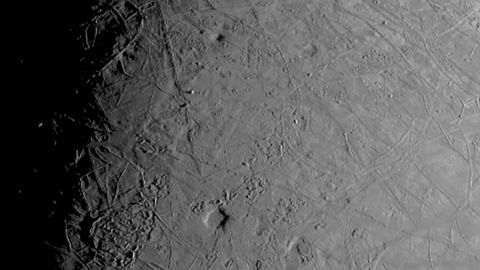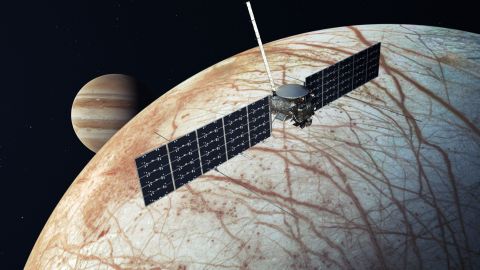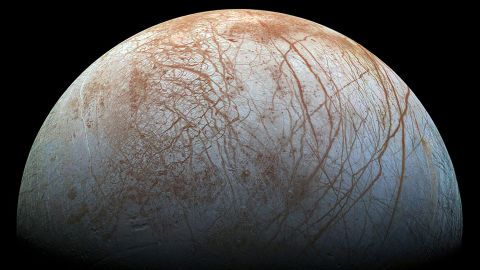[ad_1]
Sign up for CNN’s Wonder Theory science newsletter. Explore the universe with news on fascinating discoveries, scientific advancements and more.
CNN
—
A NASA spacecraft flew by one of the most intriguing ocean worlds in our solar system on Thursday.
The Juno spacecraft, which has been orbiting Jupiter since 2016, made its closest approach yet to the moon Europa at 5:36 a.m. ET, flying within 219 miles (352 kilometers) of its icy surface.
Juno captured some of the highest-resolution images ever taken of Europa’s ice shell. The first one has already been transmitted to Earth and shows surface features in a region north of the moon’s equator called Annwn Regio.
“Due to the enhanced contrast between light and shadow seen along the terminator (the nightside boundary), rugged terrain features are easily seen, including tall shadow-casting blocks, while bright and dark ridges and troughs curve across the surface,” a NASA release said. “The oblong pit near the terminator might be a degraded impact crater.”

The spacecraft also gathered data about the moon’s interior, where a salty ocean is thought to exist.
“It’s very early in the process, but by all indications Juno’s flyby of Europa was a great success,” said Scott Bolton, Juno principal investigator at the Southwest Research Institute in San Antonio in a statement.
“This first picture is just a glimpse of the remarkable new science to come from Juno’s entire suite of instruments and sensors that acquired data as we skimmed over the moon’s icy crust.”
The ice shell that makes up the moon’s surface is between 10 and 15 miles (16 and 24 kilometers) thick, and the ocean it likely sits on top of is estimated to be 40 to 100 miles (64 to 161 kilometers) deep.
Juno’s Microwave Radiometer instrument will study the ice crust to determine more about its temperature and composition. It’s the first time this kind of information will be collected about Europa’s frozen shell.
The data and images captured by Juno could help inform NASA’s Europa Clipper mission, which will launch in 2024 to perform a dedicated series of 50 flybys around the moon after arriving in 2030. Europa Clipper may be able to help scientists determine whether the interior ocean exists and if the moon – one of many orbiting Jupiter – has the potential to be habitable for life.

Clipper will eventually transition from an altitude of 1,700 miles (2,735 kilometers) to just 16 miles (26 kilometers) above the moon’s surface. While Juno has largely focused on studying Jupiter, Clipper will be dedicated to observing Europa.
“Europa is such an intriguing Jovian moon, it is the focus of its own future NASA mission,” Bolton said. “We’re happy to provide data that may help the Europa Clipper team with mission planning, as well as provide new scientific insights into this icy world.”
All of Juno’s instruments collected data during the flyby, including those that could measure the top layers of Europa’s atmosphere and how Europa interacts with Jupiter’s magnetic field. The team is hoping to spot a water plume rising up from cracks in the ice shell. Previous missions have spied plumes of water vapor erupting into space through the ice shell.
INTERACTIVE: Explore where the search for life is unfolding in our solar system
“We have the right equipment to do the job, but to capture a plume will require a lot of luck,” Bolton said. “We have to be at the right place at just the right time, but if we are so fortunate, it’s a home run for sure.”
Juno is in the extended part of its mission, which was set to end in 2021. The spacecraft is now focused on performing flybys of some of Jupiter’s moons. The spacecraft visited Ganymede in 2021 and will zoom by Io in 2023 and 2024. Its mission is now set to end in 2025.
The Europa maneuver shortened Juno’s orbit around Jupiter from 43 to 38 days.

The spacecraft’s flyby was quick, zooming by the moon at 52,920 miles per hour (85,167 kilometers per hour).
Europa is about 90% of the size of Earth’s moon, and Juno’s flyby was the closest a NASA spacecraft has come to it since the Galileo mission flew by in 2000.
“The science team will be comparing the full set of images obtained by Juno with images from previous missions, looking to see if Europa’s surface features have changed over the past two decades,” said Candy Hansen, a Juno coinvestigator who leads planning for the JunoCam camera at the Planetary Science Institute in Tucson, Arizona, in a statement.
[ad_2]
